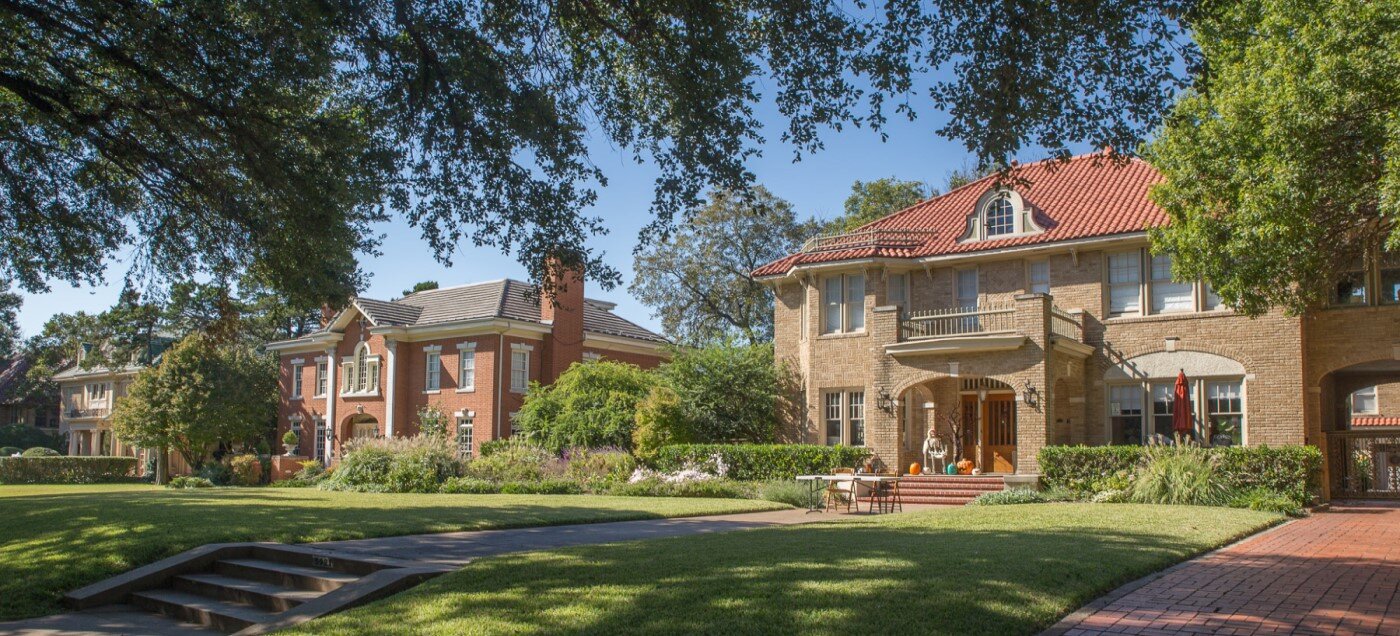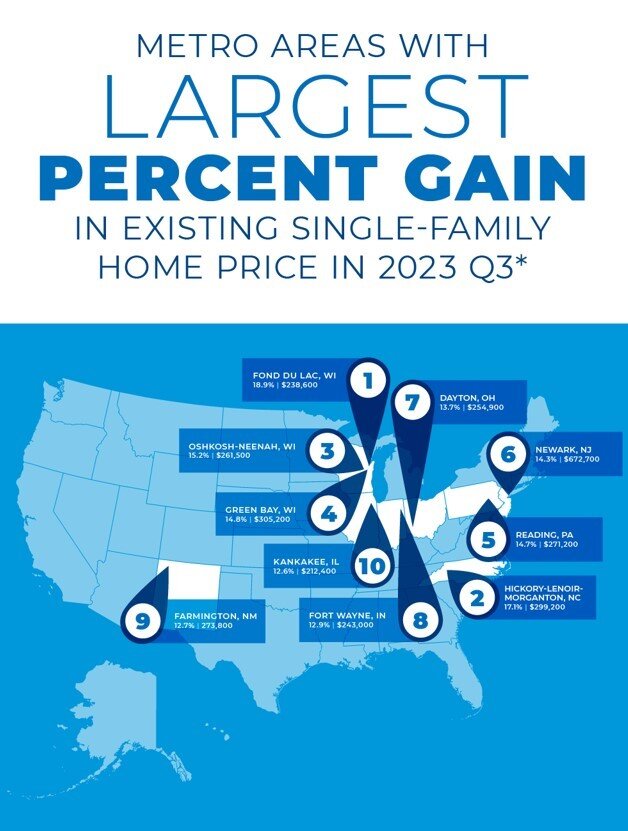Residential Real Estate News

Over 80 Percent of U.S. Metros Experienced Home Price Increases in Q3
Residential News » Dallas Edition | By Monsef Rachid | November 10, 2023 8:33 AM ET
According to the National Association of Realtors' latest quarterly report, more than 80% of metro markets (182 out of 221) posted home price gains in the third quarter of 2023 as the 30-year fixed mortgage rate ranged from 6.81% to 7.31%.
Eleven percent of the 221 tracked metro areas registered double-digit price increases over the same period, up from 5% in the second quarter.

"Homeowners have accumulated sizable wealth, with a typical homeowner gaining more than $100,000 in overall net worth since 2019 and before the height of the pandemic," said NAR Chief Economist Lawrence Yun. "However, the persistent lack of available homes on the market will make the dream of homeownership increasingly difficult for younger adults unless housing supply is significantly boosted."
Compared to a year ago, the national median single-family existing-home price climbed 2.2% to $406,900. In the previous quarter, the year-over-year national median price declined 2.4%.
Among the major U.S. regions, the South saw the largest share of single-family existing-home sales (46%) in the third quarter, with year-over-year price appreciation of 1.7%. Prices also grew 5.3% in the Northeast, 5.2% in the Midwest and 0.6% in the West.
Year-over-year prices in the third quarter retreated by 10.3% in Austin, 1.5% in Phoenix, 1.2% in Salt Lake City and 1.1% in both Dallas and Houston. However, prices rose by 9.6% in San Jose, 8.7% in both Anaheim and San Diego, 6.6% in Boston and 5.7% in Miami.
"Following the big price changes during the last several years, it's natural to witness momentary swings in prices," Yun said. "Some markets that experienced sizable home price gains since 2020 have turned lower, resulting in temporary relief for prospective home buyers. Also, a few markets in the West that experienced price declines in the prior quarter have seen prices rise again."
The top 10 metro areas with the largest year-over-year price increases all recorded gains of at least 12.6%, with six of those markets in the Midwest. Those include Fond du Lac, Wis. (18.9%); Hickory-Lenoir-Morganton, N.C. (17.1%); Oshkosh-Neenah, Wis. (15.2%); Green Bay, Wis. (14.8%); Reading, Pa. (14.7%); Newark, N.J.-Pa. (14.3%); Dayton, Ohio (13.7%); Fort Wayne, Ind. (12.9%); Farmington, N.M. (12.7%); and Kankakee, Ill. (12.6%).
Eight of the top 10 most expensive markets in the U.S. were in California. Overall, those markets are San Jose-Sunnyvale-Santa Clara, Calif. ($1,850,000; 9.6%); Anaheim-Santa Ana-Irvine, Calif. ($1,305,000; 8.7%); San Francisco-Oakland-Hayward, Calif. ($1,300,000; 1.6%); Urban Honolulu, Hawaii ($1,061,900; -5.8%); San Diego-Carlsbad, Calif. ($978,500; 8.7%); Salinas, Calif. ($945,300; 5.3%); Oxnard-Thousand Oaks-Ventura, Calif. ($921,500; 3.8%); Los Angeles-Long Beach-Glendale, Calif. ($897,600; 1.4%); San Luis Obispo-Paso Robles, Calif. ($889,900; 1.7%); and Boulder, Colo. ($857,800; 3.7%).
"With consumer inflation becoming more manageable, the Federal Reserve needs to consider cutting interest rates," Yun added. "In turn, Congress must consider incentives to boost housing supply and inventory so that more Americans can participate in wealth accumulation. The housing market shouldn't be accessible only to those who are paying in cash nor become a playground for the wealthy."
Less than one-fifth of markets (17%; 38 of 221) experienced home price declines in the third quarter, down from 41% in the second quarter.
Housing affordability worsened in the third quarter because of increasing home prices and mortgage rates. The monthly mortgage payment on a typical existing single-family home with a 20% down payment was $2,192, up 7% from the second quarter ($2,051) and 19.2% - or $354 - from one year ago. Families typically spent 26.8% of their income on mortgage payments, up from 25.3% in the prior quarter and 23.5% one year ago.
Lack of inventory and affordability continued to impact first-time buyers during the third quarter. For a typical starter home valued at $345,900 with a 10% down payment loan, the monthly mortgage payment rose to $2,149, up 6.9% from the previous quarter ($2,011). That was an increase of $343, or 19%, from one year ago ($1,806). First-time buyers typically spent 40.4% of their family income on mortgage payments, up from 38.2% in the prior quarter.
A family needed a qualifying income of at least $100,000 to afford a 10% down payment mortgage in 45.7% of markets, up from 40.3% in the prior quarter. Yet, a family needed a qualifying income of less than $50,000 to afford a home in 2.7% of markets, down from 6.3% in the previous quarter.

Sign Up Free | The WPJ Weekly Newsletter
Relevant real estate news.
Actionable market intelligence.
Right to your inbox every week.
Real Estate Listings Showcase
Related News Stories
Residential Real Estate Headlines
- Las Vegas Area Home Prices Uptick 4.3 Percent Annually in March
- Single-Family Rent Growth in U.S. Trends Upward in 2025
- U.S. Mortgage Rates Tick Down Post Trump Tariffs Commencement
- President Trump's 'Liberation Day' Tariffs Potential Impact on the U.S. Housing and Mortgage Markets
- Baby Boomers Biggest Cohort of U.S. Home Buyers in 2025 as Millennials Decline
- U.S. Monthly Housing Payments Hit Record High in 2025
- U.S. Pending Home Sales Uptick in February
- Global Prime Residential Rent Slowdown Continued in Late 2024
- Ireland Home Price Inflation Hits 8 Year High in Early 2025
- Existing Home Sales in America Uptick in February
- Great Miami Area Residential Sales Decline 15 Percent Annually in February
- Mortgage Rates Uptick in Mid-March, Ending 9-Week Decline in U.S.
- World Property Ventures Builds the Future of Real Estate with New Funding Round
- U.S. Builder Sentiment Declines Amid Economic Uncertainty and Rising Costs
- Black Homeownership Rates in U.S. Enjoy Largest Annual Increase of All Racial Groups
- Wealthy Renters Are Taking Over More of the U.S. Rental Market
- If U.S. Congress Does Not Extend NFIP Soon, Thousands of Daily Home Closings Impacted
- U.S. Mortgage Applications Spike 11 Percent in Early March
- Greater Palm Beach Area Residential Sales Rise in Early 2025
- New Apartments in U.S. Are Leasing at Slowest Pace on Record
- U.S. Mortgage Rates Drop to 4 Month Low in March
- Overall U.S. Mortgage Delinquency Rates Dip in December
- New Tariffs on Canada, Mexico to Impact U.S. Homebuilder Input Costs
- Monaco's Property Market: A Tale of Two Cities
- U.S. Home Purchase Cancellations Surge, 1 in 7 Sales Getting Canceled
- U.S. Pending Home Sales Hit Historic Low in Early 2025
- Greater Miami Area Residential Sales Dip in January
- Governor DeSantis Supports Ending Property Taxes in Florida
- WPV Aims to Become the Berkshire Hathaway of Real Estate Tech
- U.S. Home Sales Slump Continues in January
- Average Americans Spend 38 Percent of Monthly Income on Mortgage Payments
- Switzerland's Safe-Haven Appeal Grows with World's Wealthy Homebuyers
- U.S. Builder Confidence Rapidly Declines in February
- Las Vegas Home Sales Rise 6.7 Percent Annually in January, Condo Sales Dip
- Homebuyer Demand in America Drops to 5-Year Low in Early 2025
- Ownership More Affordable Than Renting in Most U.S. Markets
- The World's First Global Listings Service Launches, Called a GLS
- Home Prices Continue to Rise in 89 Percent of U.S. Metros in Late 2024
- Global Luxury Residential Prices Showed Gradual Improvement in Late 2024
- U.S. Construction Hiring Rate Drops to Lowest Levels in 5 Years





